The tomb of Napoleon Bonaparte is located under the Hôtel des Invalides in Paris, built between 1842-1861. It's designed to reflect his status as a military genius and leader, with a grand crypt and ornate decorations celebrating his achievements. The sarcophagus, made of red quartzite, weighs 18 tons and is surrounded by intricate details, creating a sense of reverence and awe for the historical figure.


Capturing the Dome's Embrace
Rating: Subject: 9/10
This image plunges us into the dizzying height and opulent detail of a grand, domed interior, likely a church or monument of significant historical weight like the Dôme des Invalides in Paris. What's happening is a classic tourist tableau: a collection of visitors are scattered throughout the vast space, gazing upwards, consulting guides, taking photos, and generally trying to process the sheer scale and artistry surrounding them. The mood is one of reverent awe mixed with the low hum of visitor activity. From a photographic standpoint, the composition valiantly attempts to encompass the entire scene using a wide-angle lens, leading the eye from the intricately patterned floor up the massive fluted columns, past the lower arches and painted pendentives, culminating in the breathtaking, gilded, and frescoed dome overhead. The lighting, predominantly natural light streaming in from the high windows, creates dramatic contrasts, illuminating the upper reaches while leaving some lower areas in shadow, a common challenge in capturing such interiors.
The critique here is less about the subject (which is undeniably spectacular) and more about the photographic feat attempted. Capturing such immense scale and detail, especially looking straight up, is notoriously difficult. The wide-angle distortion is noticeable, bending the tall columns slightly inwards as they stretch towards the sky – a classic perspective challenge photographers face in these spaces, sometimes adding to the sense of grandeur, sometimes just looking a bit wonky. Color-wise, the warm stone and vibrant gold of the architecture contrast nicely with the cooler light and the blues and greens in the ceiling frescoes, though dynamic range is tested by the bright windows. The inclusion of people, while potentially cluttering a 'pure' architectural shot, provides crucial scale, highlighting just how enormous this space is and grounding the viewer in the scene. The photographer has done a commendable job wrestling with the light and perspective to give a sense of the overwhelming 'wow' factor, though perhaps a bracketed exposure series or careful post-processing would be needed to fully tame the highlights and shadows in a space where heaven meets earth...or at least, really tall ceilings.
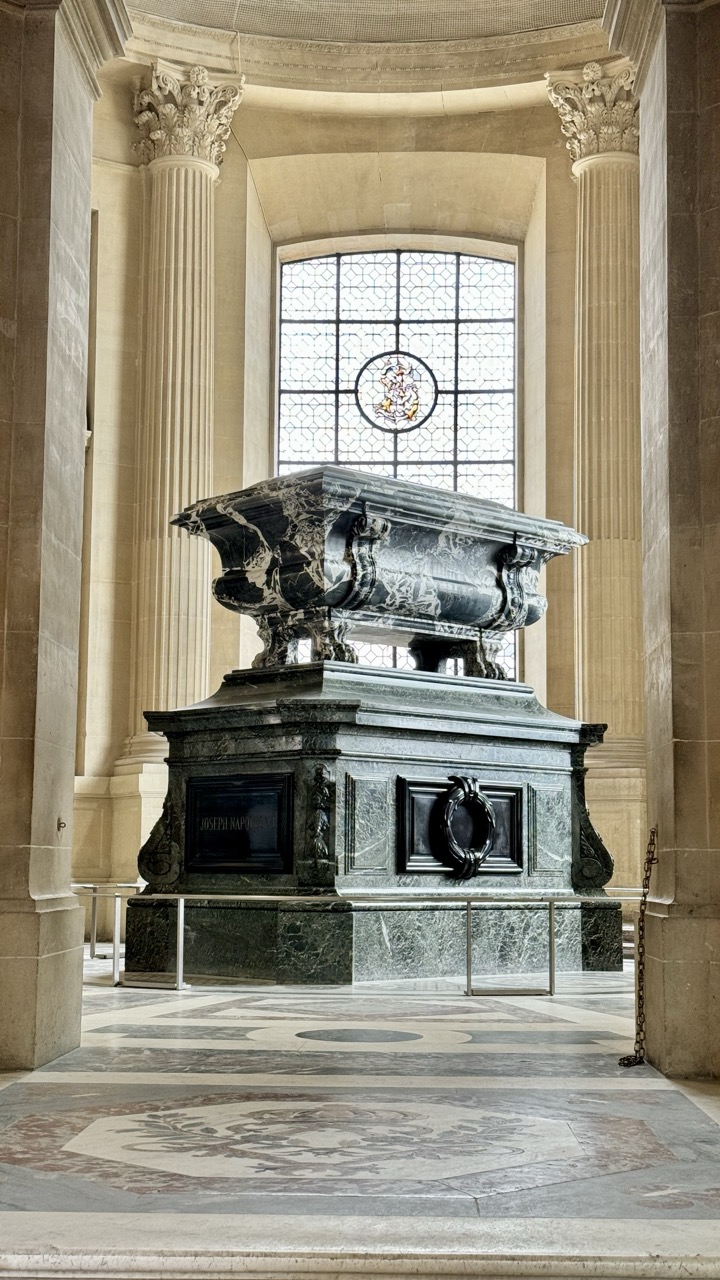

A Monumental Resting Place
Rating: 8/10 (Historical significance and grandeur make it impressive, but it is, after all, just a large box.)
Step right up, folks, and behold the final resting place of someone important enough to warrant this much rock! This image captures a colossal dark green marble tomb, nestled grandly within a magnificent, echoing chamber. The inscription on the front reads "JOSEPH NAPOLEON," letting us know who scored this prime piece of real estate in the afterlife. Surrounded by imposing fluted columns and bathed in the soft, diffusive light from a massive, geometrically-patterned window with a central stained-glass medallion, the tomb sits upon an equally substantial base, complete with a solemn wreath detail. Metal railings keep the curious (and probably overly enthusiastic) tourists at bay, maintaining the somber, majestic tone of the scene. The intricate marble inlay pattern on the floor below adds another layer of visual interest and speaks to the overall opulence of this historical space.
From a photographic perspective, the composition centers the imposing subject effectively, using the architectural lines of the building to frame it and emphasize its scale. The natural light pouring in from the large window provides soft, atmospheric illumination, though it does create a bit of a silhouette effect on the upper part of the tomb, challenging the dynamic range. The contrast between the cooler tones of the stone architecture and the rich, dark green of the marble tomb works well visually. While the symmetry is pleasing, capturing this weighty subject from a slightly lower angle might have enhanced its imposing presence even further. Overall, it's a solid capture of a significant historical artifact within its breathtaking setting, despite the minor compositional challenge posed by the protective railings.
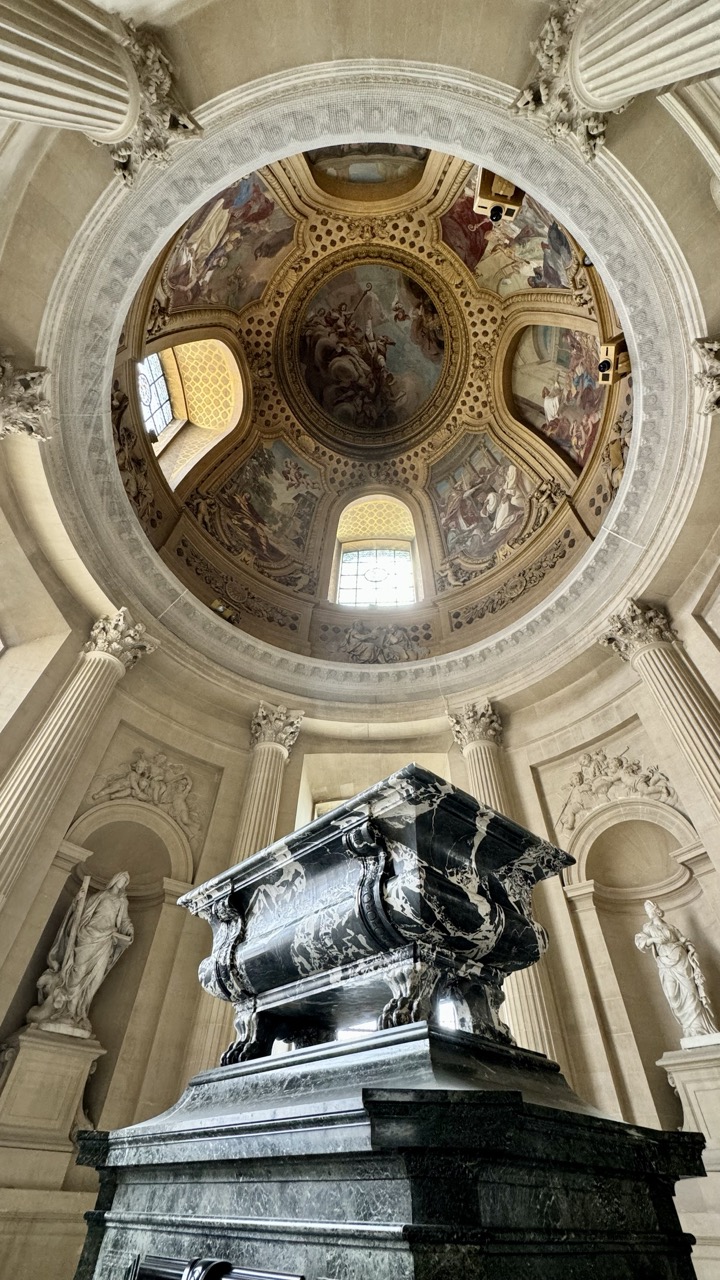

The grand finale of monuments, featuring a subject whose permanence is undeniable, earning a solid 8/10 for historical gravitas. The scene unfolds within a vast, domed interior, where a colossal, dark, and highly polished sarcophagus dominates the foreground, looking every bit like a final resting place meant to impress even the most skeptical undertaker. Nothing is 'happening' in the action sense, but the sheer scale and elaborate decoration convey a powerful sense of history and solemn reverence. The mood is undeniably grand and imposing, perhaps slightly overwhelming, prompting contemplation on mortality or just making you crane your neck to admire the ceiling art.
From a photography perspective, the low-angle composition brilliantly captures the towering height of the space, drawing the eye up past the weighty tomb towards the magnificent dome above. The lighting, with rays filtering in from unseen high windows, creates dramatic highlights and shadows, accentuating the architectural details and adding depth. The color palette is rich, contrasting the dark, almost black-green marble of the tomb with the warm tones of the stone architecture and the vibrant, if aged, hues of the ceiling frescoes. The wide-angle lens effectively conveys the immense scale, though it slightly distorts the perspective, making the dome feel even more vast – a classic technique for conveying grandeur, even if it makes you feel a bit like an ant who wandered into Versailles. The intricate details on the Corinthian columns, the relief carvings on the walls, and the distant statues in their niches all contribute to the overall sense of opulence and historical significance, beautifully rendered by the natural light.
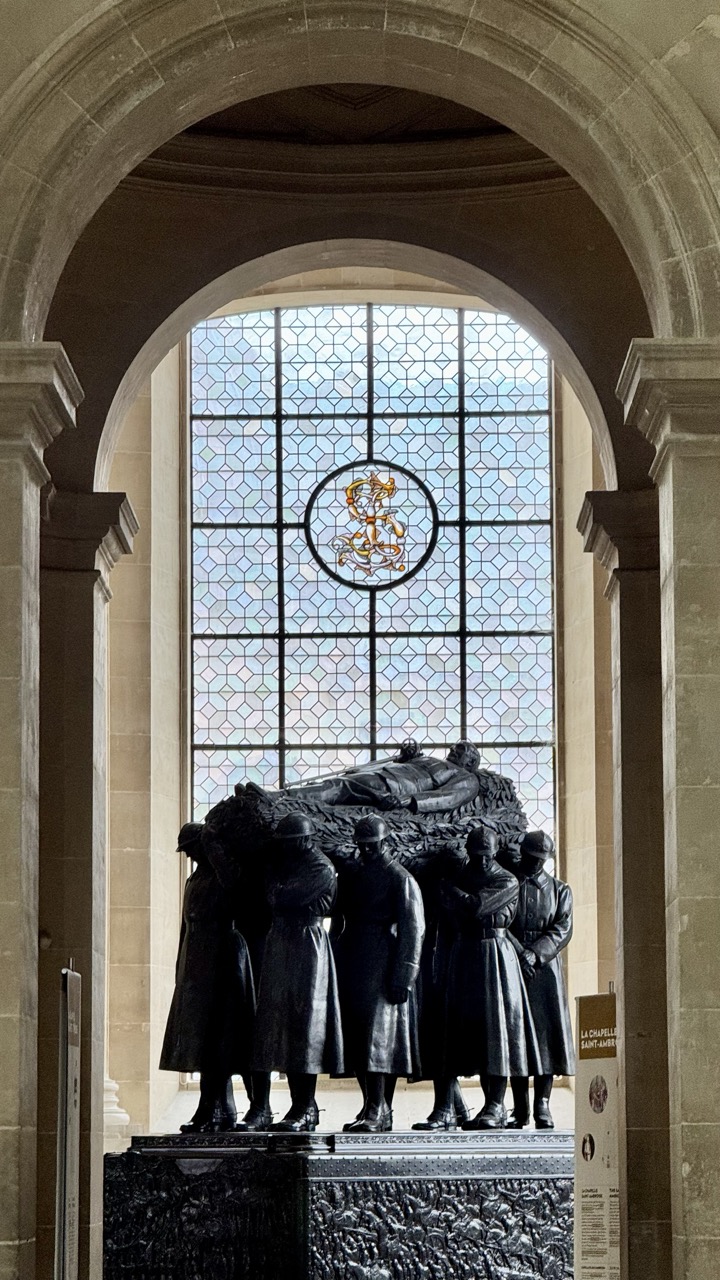

Solemn Watchers
Rating: 8/10
This image captures a deeply somber scene: a large, dark bronze sculpture of a deceased figure lying atop a sarcophagus, supported by a procession of seven stoic, life-sized figures clad in heavy coats and helmets. They look like soldiers, eternally standing guard or bearing the weight of history. The overall mood is one of reverence, gravitas, and loss, amplified by the grand architectural setting. This appears to be a significant memorial or tomb within a large, possibly religious, building, with massive stone arches framing the central subject like a proscenium arch. The sheer scale of the sculpture and the surrounding space is palpable, suggesting a figure of great importance is being commemorated.
From a photographer's viewpoint, the composition is strong, employing classical symmetry with the sculpture perfectly centered beneath the arch and aligned with the large window behind it. The natural light pouring through the patterned stained glass window creates a dramatic backlit effect, silhouetting the dark sculpture and emphasizing its form rather than intricate detail – a common challenge when photographing dark subjects against bright backgrounds. While this enhances the atmospheric gloom, it does mean we lose some definition on the figures' faces and clothing, making them appear almost monolithic. The limited color palette of stone, bronze, and the cool tones of the window is punctuated by the striking circular stained glass medallion featuring a dynamic, golden creature, adding a surprising, almost whimsical element to the otherwise serious scene. The vertical format effectively conveys the height and grandeur of the space. It's a powerful shot, capturing the weight of memory and the endurance of stone and stained glass, though perhaps next time, a little fill light on those vigilant guardians might help us appreciate their dedication (and give their knees a break!).
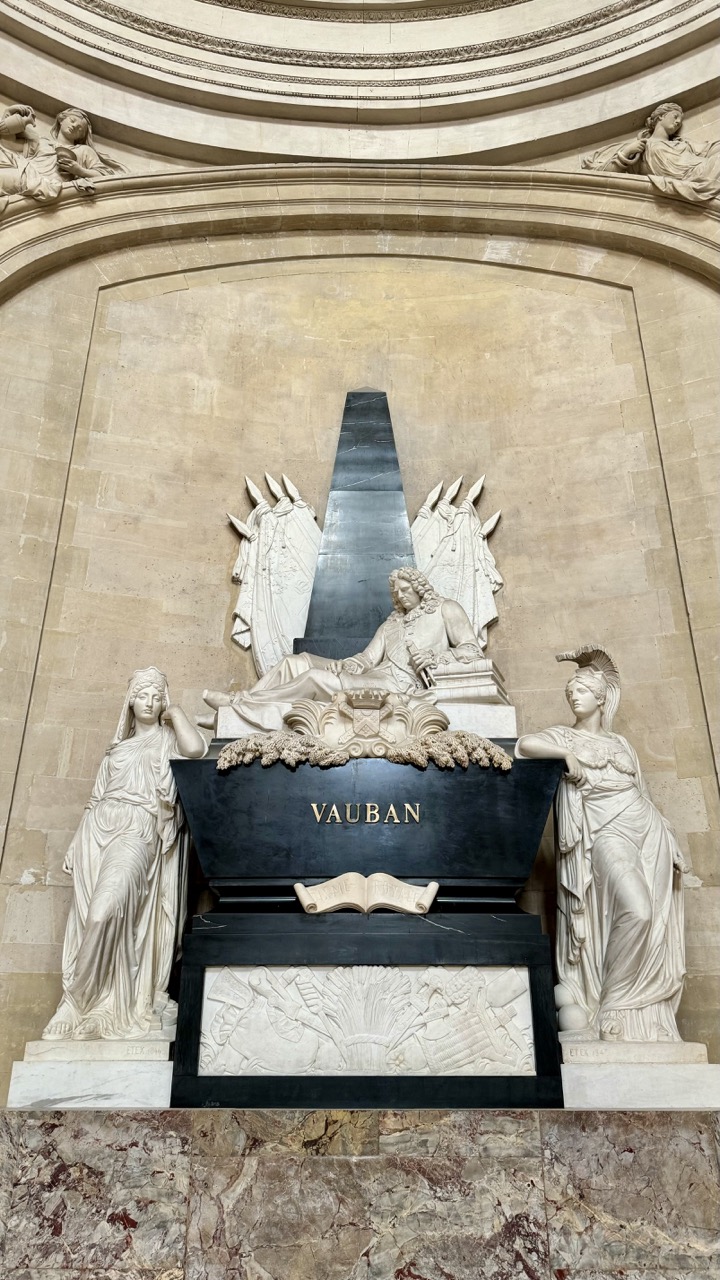

The Grand Tomb of Vauban
Rating: 7/10
This image captures a large, neoclassical tomb featuring multiple white marble sculptures set against a neutral-toned stone wall. The central figure, presumably Vauban, reclines upon a dark, imposing sarcophagus, looking rather comfortable for someone meant to be, well, *in* it. He's flanked by two standing female allegorical figures, one on the left looking serene and contemplative, the other on the right sporting a rather cool plumed helmet and resting her arm on the tomb's edge like she's just leaning in for a chat. The name "VAUBAN" is inscribed prominently in gold lettering on the dark marble. Below this, a carved relief on the base depicts what appears to be fortification elements and possibly agricultural symbols, hinting at Vauban's dual genius in military engineering and economics. Above the sarcophagus, behind the reclining figure, are abstract or stylized winged shapes or figures, adding to the monumental scale. The overall mood is one of solemn historical tribute and grandeur.
From a photographic perspective, the composition is quite symmetrical, framing the central monument effectively. The slightly low angle emphasizes the scale and height of the structure, making it feel imposing, though it also means we're looking slightly up at everyone. The lighting is even, perhaps a bit flat, which makes the details of the white marble sculptures stand out clearly against the darker stone and sarcophagus, but doesn't create dramatic shadows or highlights. The limited color palette of whites, dark greys, and beige/tan suits the subject's gravitas. The background shows the curved architecture of the building, likely a dome or apse, with decorative moldings and further relief sculptures visible higher up, adding context to the location's importance. It's a solid documentary shot capturing the essence of the monument, though perhaps a slightly more dynamic angle or lighting could have elevated it from competent record to captivating artwork. Still, it gets the job done for the historical record!
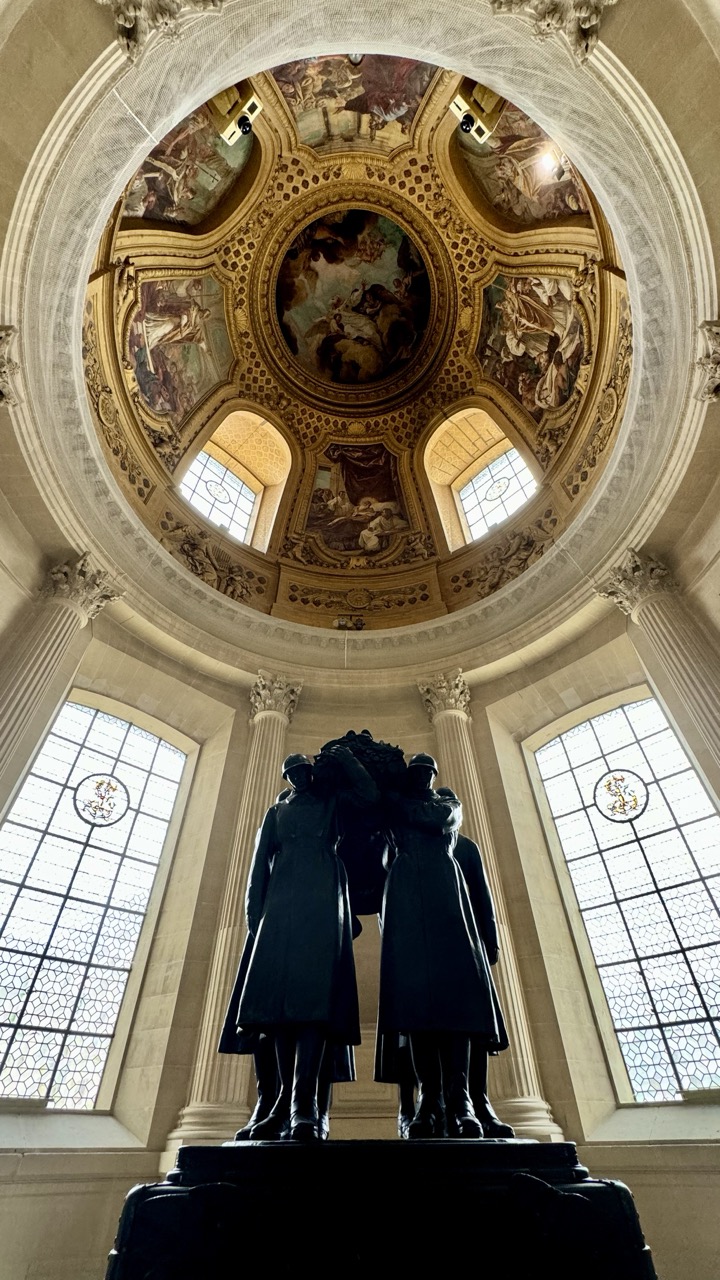

Looking Up in Grande Style
Rating: 9/10
Standing dwarfed by history, this image captures a dark, monumental statue of several figures, appearing to be soldiers bearing a heavy burden, viewed from an extremely low angle within a vast, ornate chamber. They are silhouetted against large, geometric-patterned windows, their solemn forms grounding the composition amidst the soaring architecture. Above them, a magnificent golden dome unfolds, adorned with intricate patterns, smaller arched windows, and vibrant fresco paintings depicting dynamic scenes. The space is defined by tall, fluted columns reaching towards the heavens of the ceiling. The mood is one of solemn grandeur and historical weight, balanced by the breathtaking beauty and scale of the architectural and artistic elements above.
From a photographic perspective, the extreme low angle is the star here, effectively exaggerating the verticality and immense scale of the building and its dome. It turns the statue into a powerful, dark mass anchoring the frame while forcing the viewer's eye upwards in an 'awe' perspective – just try looking at this image without tilting your head back! The lighting is primarily natural, flooding in from the large windows and creating dramatic backlighting and silhouettes, adding depth and highlighting the textures of the architecture and the golden richness of the dome. Compositionally, the vertical format reinforces the height, though the wide-angle lens causes some distortion, particularly noticeable at the edges of the dome, which surprisingly adds to the sense of expansive volume. It’s a tricky shot, sacrificing the clear detail of the foreground subject for the sake of capturing the overwhelming environment, and while you might get a crick in your neck from the real thing, this photo saves you the chiropractor visit.
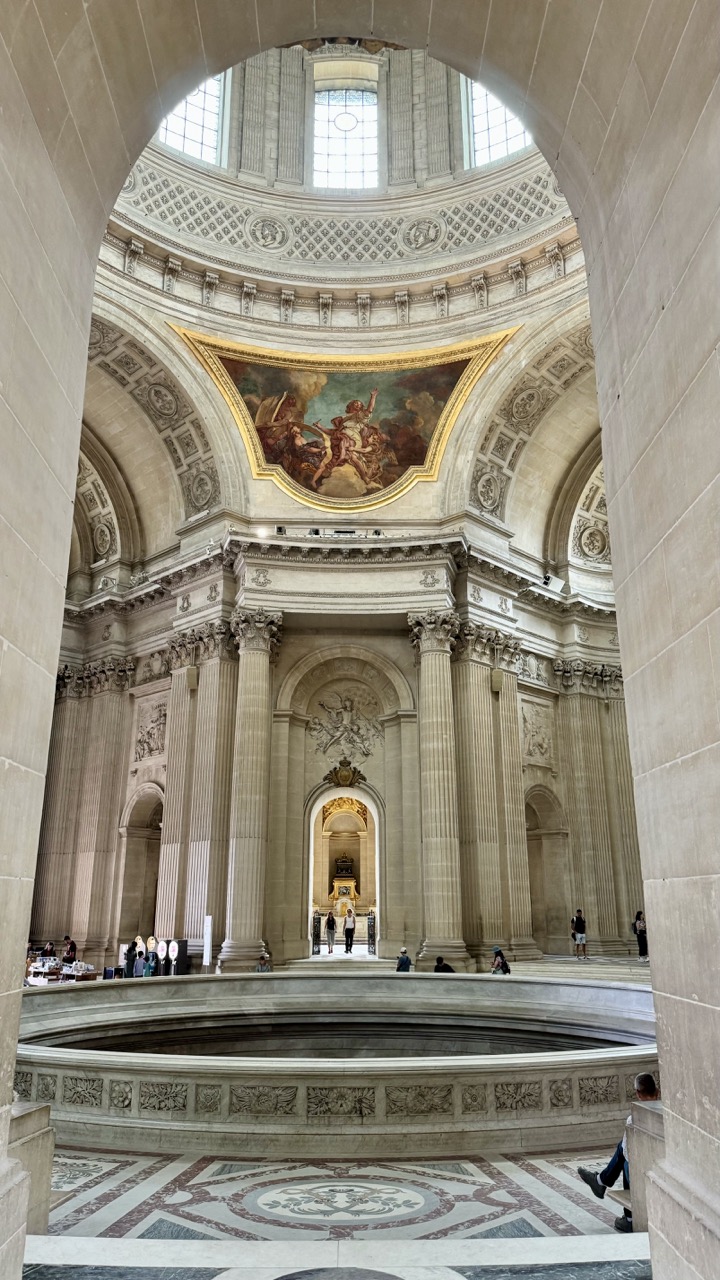

Grand Dome of Ages
Rating: 9/10
This image captures the breathtaking interior of a monumental building, likely a panthéon or grand cathedral, centered around a colossal dome and the circular space below. The subject is the sheer scale and intricate detail of the architecture, a true feast for the eyes, scoring high for its historical and visual impact. We see visitors milling about on the ground level, looking up, sitting, and providing a sense of scale against the overwhelming structure. The mood is one of reverent awe mixed with the casual buzz of tourism; people are humbled by the grandeur but comfortably exploring.
Compositionally, the shot is framed by the imposing arches in the foreground, drawing the eye into the vast central space. The symmetrical layout, with columns leading up to the ornate dome and the dramatic painting at its apex, creates a powerful sense of depth and height. Lighting is primarily natural, filtering in from the windows high above, casting highlights and shadows that emphasize the architectural features and give the stone surfaces a warm glow. However, those high windows are quite bright, pushing the exposure limits. The color palette is dominated by the warm, muted tones of the stone and marble, beautifully contrasted by the vibrant, rich colors of the ceiling fresco, which acts as a key focal point. The circular balustrade in the foreground, with its detailed carvings, adds a layer of visual interest and separates the lower viewing area from the main floor. It's a classic example of trying to capture an immense indoor space, requiring a wide angle to fit it all in and careful handling of the challenging lighting conditions.
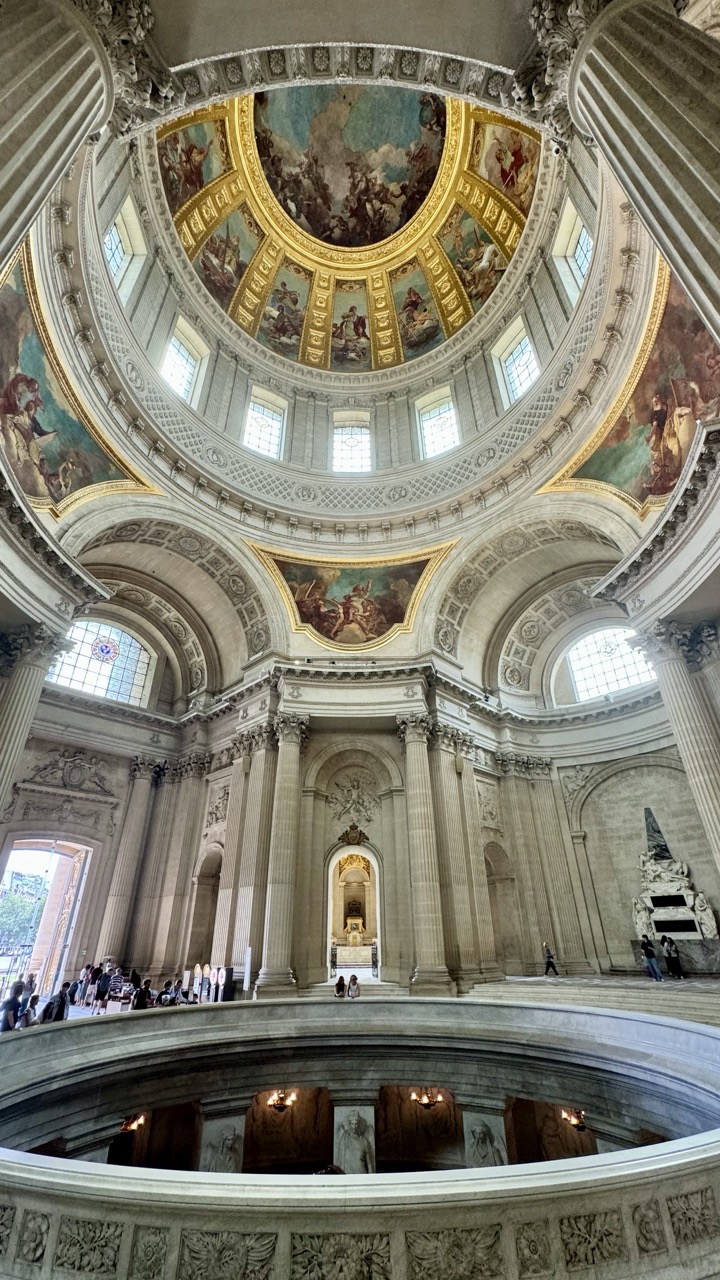

Grand Dome Gaze
Rating: 9/10
This image plunges us into the breathtaking interior of a grand, classical building, likely a monument or a church, with our gaze drawn upward towards an enormous, highly decorated dome ceiling. Painted frescoes depicting biblical or historical scenes fill the vast expanse, framed by ornate golden borders and punctuated by arched windows allowing bright daylight to stream in. Below, we see a circular balcony railing in the foreground, from which visitors lean and observe the spectacle above or the level below. A crowd of people mills about on the balcony, some looking upwards, others seemingly relaxing or conversing, providing a crucial sense of scale to the monumental architecture. Further back, through large arched openings, more architectural details, pillars, and perhaps distant altars or monuments are visible, along with more people exploring the space. The overall mood is one of awe and historical weight, a testament to human artistry and ambition, yet tempered by the presence of everyday visitors experiencing it.
From a photographic standpoint, this wide-angle shot effectively captures the immense scale and height of the interior, though the inherent distortion warps the vertical columns into leaning towers, a common side effect of trying to cram such grandeur into a frame – perhaps the photographer literally had a crick in their neck trying to get it all in. The composition uses the circular railing in the foreground to create a sense of depth and frame the view upwards. Lighting is challenging in such a space, with bright windows contrasting with the darker lower levels, yet the exposure seems reasonably balanced, highlighting the vibrant colors and intricate details of the ceiling paintings while still revealing features lower down. The rich, warm colors of the stone and gold provide a sense of timeless luxury, contrasting slightly with the blues and greens of the painted sky and the casual clothing of the modern-day tourists. It's a classic approach to capturing these kinds of spaces, prioritizing the overwhelming scale over perfect perspective, reminding us that sometimes, just getting the whole jaw-dropping scene is the main goal.
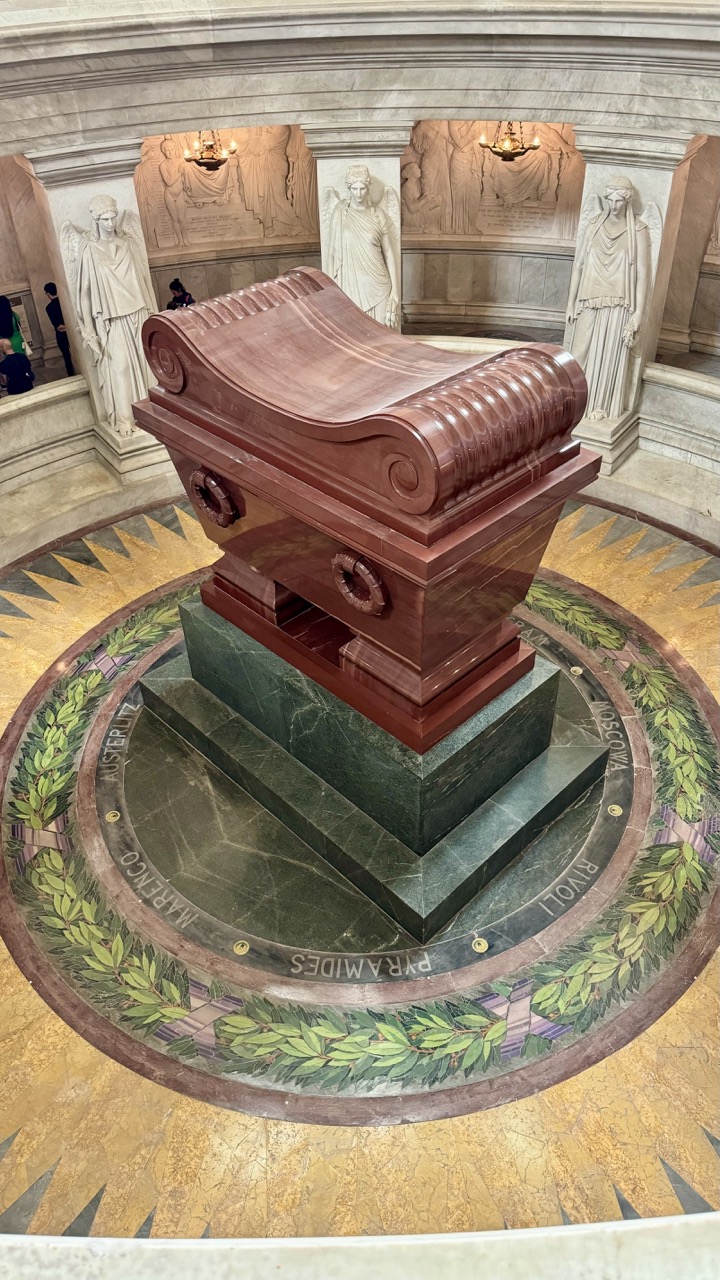

The Emperor's Giant Red Box
Rating: 9/10
Ah, the final resting place of the little big man himself, Napoleon Bonaparte, looking rather comfortable in his colossal sarcophagus of reddish-brown porphyry. It's like a very expensive, oversized bathtub carved from solidified power. Subject rating: a solid 9/10 for historical heft and sheer "look at me" energy. We're peering down from above into the central pit at Les Invalides in Paris, where the Emperor's tomb rests majestically on a base of green Vosges granite. The circular floor mosaic below him is a masterpiece in itself, a radiant sunburst surrounded by laurel wreaths and the names of his greatest hits – Austerlitz, Marengo, Pyramides, Rivoli, Moskova – etched for eternity, ensuring no one forgets his travel itinerary.
From this high-angle viewpoint, the composition perfectly captures the monumental scale of the tomb and the meticulous, almost theatrical, design of the space. The deep, rich red of the sarcophagus is the obvious star, beautifully contrasting with the cool greens and the warm, detailed gold of the floor mosaic. The ambient lighting from the dome above lends a somewhat solemn but clear illumination, highlighting the polished surfaces and intricate details. The surrounding architecture and the distant, somewhat blurry figures of fellow tourists in the background add perspective, reminding us that even in death, Napoleon is still commanding attention (and probably causing queues). It's a grand subject, captured effectively, albeit perhaps with the slight vertical perspective distortion common in high-angle mobile shots, but it certainly conveys the awe-inspiring scale of the Emperor's very permanent address.
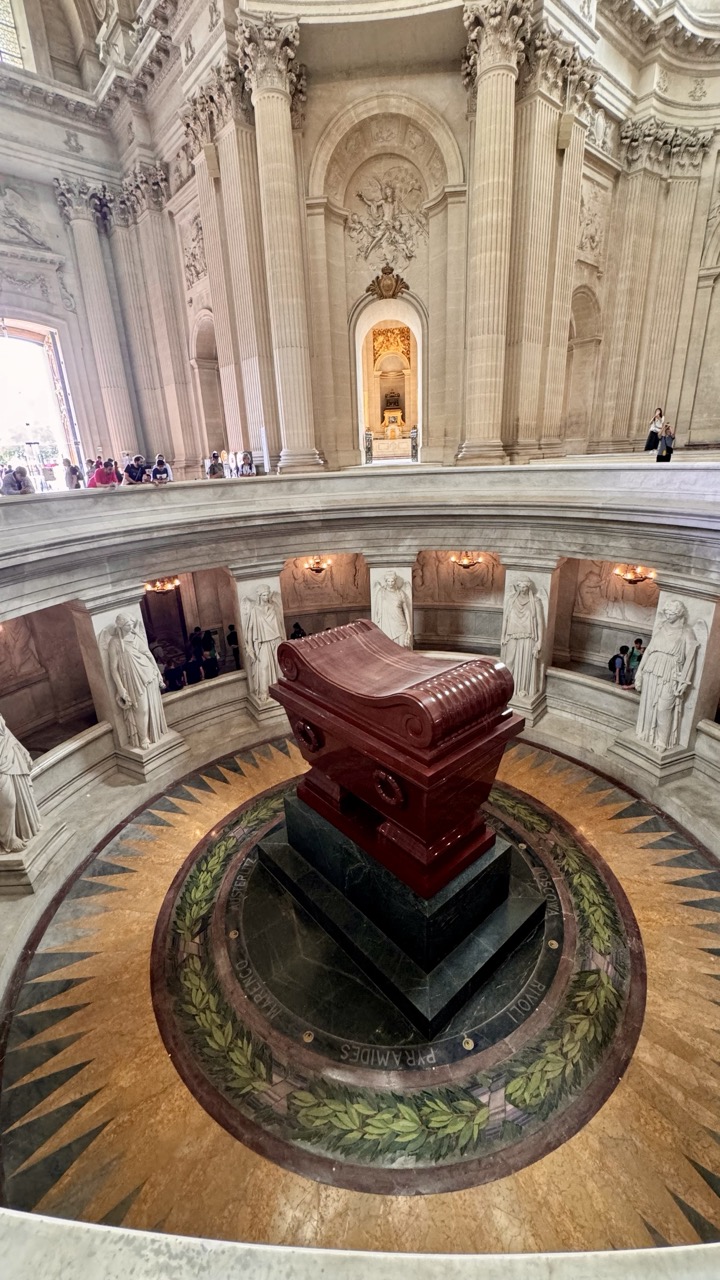

Napoleon's Grand Resting Place
Rating: 9/10
Stepping into the colossal dome of Les Invalides, the eye is immediately drawn down to the central figure: Napoleon Bonaparte's monumental red porphyry sarcophagus. This image captures the sheer scale and grandeur of the tomb's setting, viewed from an upper-level balcony, offering a panoramic perspective of the circular crypt below. Tourists, tiny figures against the massive architecture, mill about on multiple levels, craning their necks to take in the spectacle. The mood is undeniably solemn and historical, yet also infused with the quiet buzz of visitor activity. It feels like stepping into a hallowed space designed specifically to impress upon you the importance of the man buried within.
From a photographic standpoint, the high-angle composition is effective in showcasing the tomb as the undisputed centerpiece and highlighting the intricate circular floor pattern below, detailing Napoleon's victorious battle sites like Pyramides, Rivoli, and Austerlitz – essentially a marble greatest hits album. The wide-angle lens, while capturing the immense scale of the dome's interior and the surrounding colonnade, does introduce some perspective distortion, especially noticeable at the edges, which can be both a stylistic choice and a technical challenge. Lighting appears a mix of natural light from a large opening and artificial light illuminating the lower crypt level, creating decent visibility throughout. The deep red of the sarcophagus provides a striking contrast against the predominantly beige and grey stone architecture and the green and gold floor decoration, making the main subject pop visually. While the high vantage point is a classic shot of this location, capturing the interplay of light and shadow on the colossal columns or perhaps a more intimate detail of the tomb itself could offer different, equally compelling narratives. The presence of tourists, while adding scale, reminds us that even the tomb of a legendary emperor is now firmly on the well-trodden path of Parisian tourism.
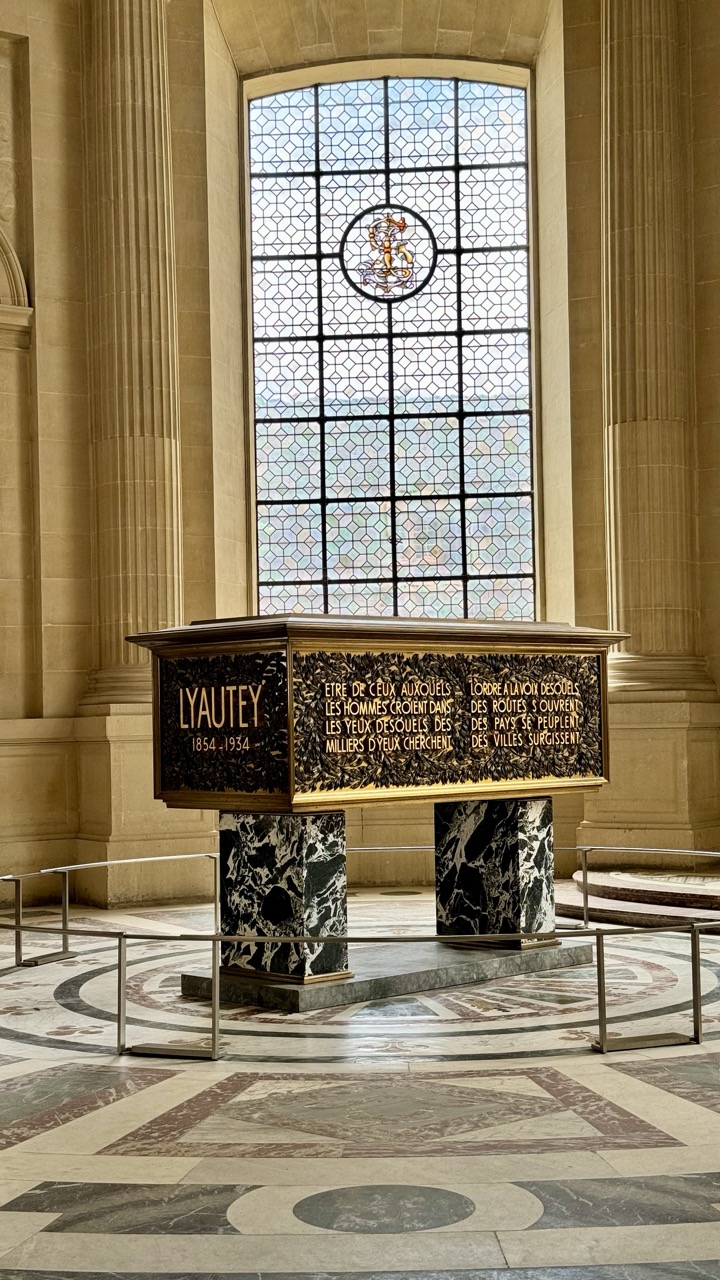

Resting in Grandeur
Subject: 7/10
Step right up, folks, and gaze upon the eternal repose of Lyautey (1854-1934), whose subject rating comes in at a respectable 7/10 for historical significance, even if it's essentially a very, *very* fancy box for eternity. This rather imposing sarcophagus, looking quite resplendent in its gilded finery with deeply carved foliage and supported by some seriously swanky black and white marble legs that wouldn't look out of place in a high-end kitchen, sits front and center, commanding the space. The prominent French inscription, promising profound ideas about believing in people and cities arising, adds a touch of intellectual heft to the otherwise silent and solemn mood of this grand interior, making you ponder more than just the impressive craftsmanship.
Photographically speaking, the composition does its best to center this monumental figure's final address beneath the watchful eye of that rather magnificent, geometric-patterned window, complete with a charming circular stained-glass emblem at the top. Natural light floods in from behind, creating a lovely, soft illumination that highlights the rich textures of the gold inscription panel and the dramatic veining of the marble supports – clearly, Lyautey believed in going out in style. The warm tones of the stone architecture contrast nicely with the cooler blues and greys of the window and floor patterns, creating a sense of dignified grandeur, even if the slightly awkward safety rails around the base feel like the historical equivalent of crowd control, slightly disrupting the visual flow. It's a solid capture of a historical monument, giving you a taste of the scale and detail, despite wishing those rails would politely step out of frame for a cleaner shot.
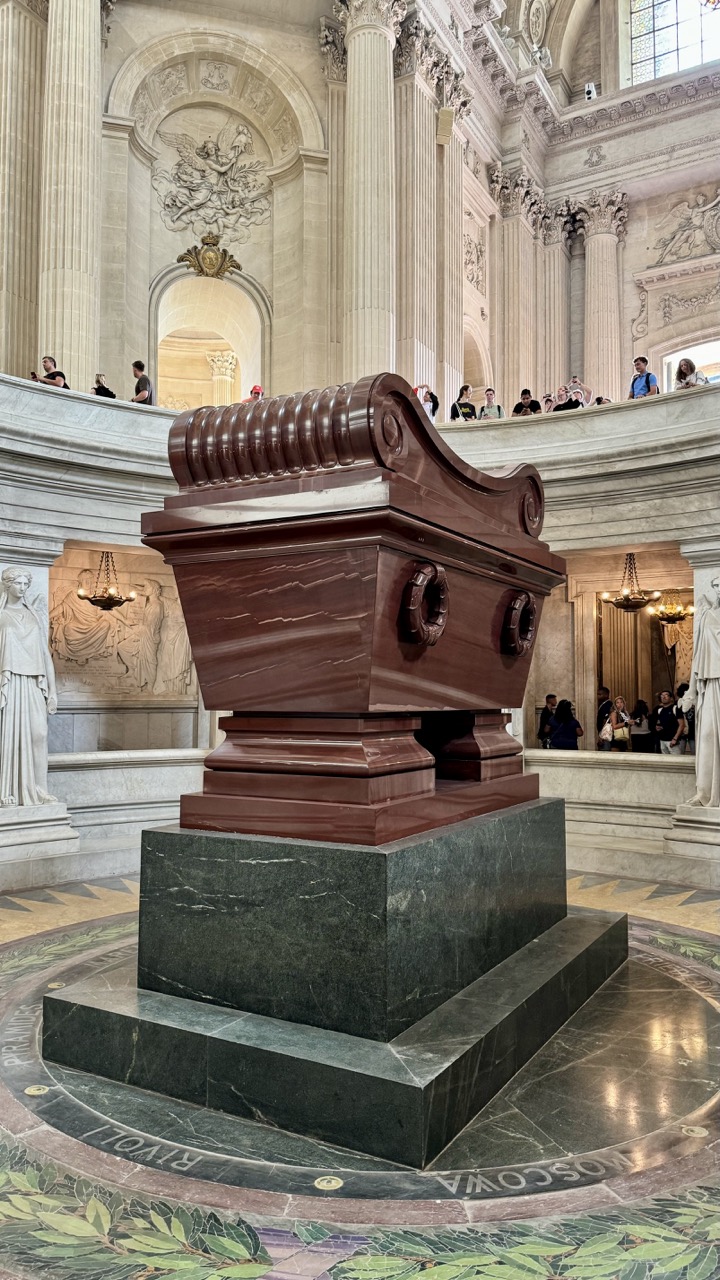

Napoleon's Red Stone Nap Spot
Rating: 7/10
Well, here we have the final, rather imposing resting place of a chap who clearly didn't do things by halves. Napoleon's tomb, a colossal sarcophagus of polished red porphyry stone, dominates the scene like a very fancy, oversized jewellery box. It sits proudly on a dark green marble plinth, drawing all eyes in the vast, columned rotunda of Les Invalides. Up above, a balcony buzzes with onlookers, their heads peering down, giving a sense of scale and perhaps wondering if history smells like old marble and tourism. The subject itself is undeniably grand and historically significant, a solid 7/10 for its sheer presence, though you can almost hear the stone sighing under the weight of centuries of tourist gazes.
From a photographic perspective, capturing this monumental structure within such a cavernous space is a challenge. The composition here centers the tomb, which is the main point, but the low angle means we lose a significant portion of the glorious dome above – a shame, as that's part of the spectacle. The lighting is a mix of dramatic ambient light from higher windows illuminating the creamy neoclassical architecture, and warmer artificial light around the perimeter, creating depth and highlights. The rich red of the tomb provides a striking focal point against the more neutral stone and the dark green base; it certainly wasn't designed to blend in. The detailed floor mosaic surrounding the base, showcasing battle names (like RIVOLI and MOSCOWA, just subtle reminders), adds a layer of historical texture at the ground level, though it's partially obscured. It's a classic "grand historical interior" shot, capturing the essence but perhaps struggling with the sheer vertical scale – next time, pack a ladder or a really wide-angle lens!
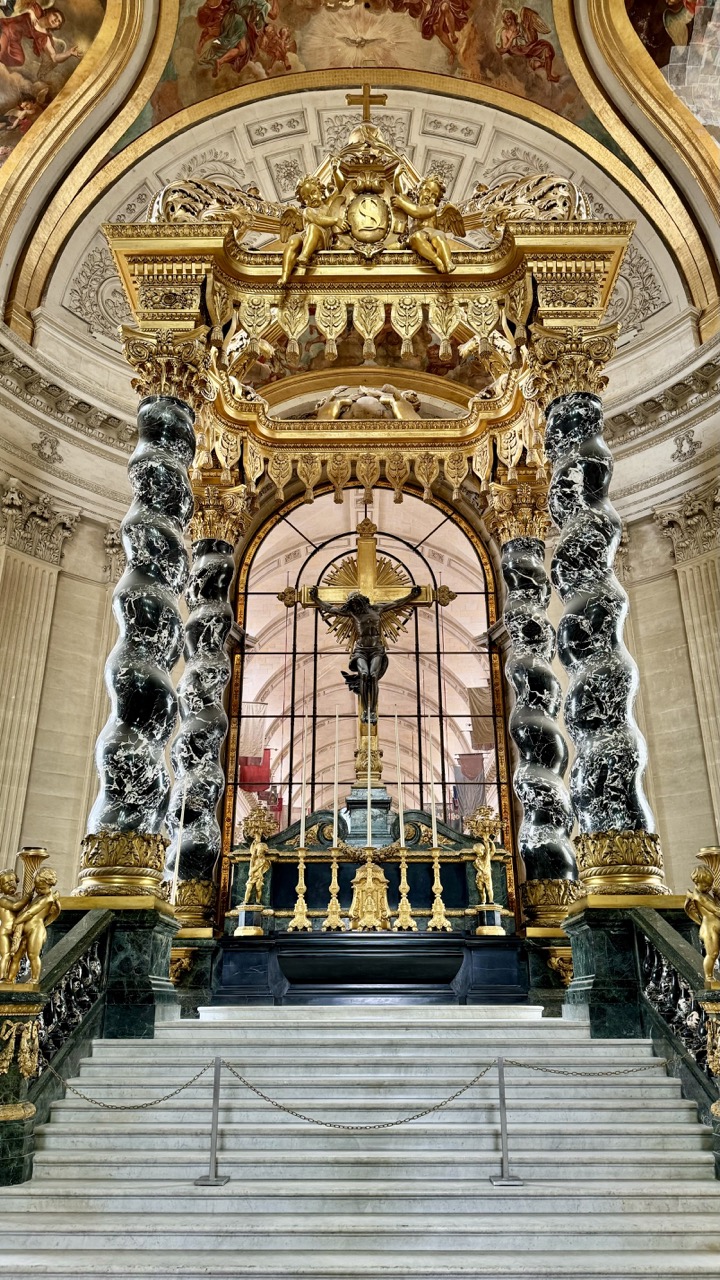

Altar of Opulence - 8.5/10
This photograph captures the breathtaking grandeur of a magnificent church altar, a subject easily rating an 8.5 out of 10 for its sheer visual impact and intricate detail. What's happening is simply the presentation of this awe-inspiring center of worship, inviting the viewer to take in the spectacle. The mood is one of overwhelming majesty and reverence, bordering on the theatrical due to the sheer opulence. In the background, glimpses of vaulted ceilings adorned with vibrant frescoes and classical architectural details frame the central scene. The image is dominated by the multi-tiered altar structure itself, featuring massive, twisted black and white marbled columns, lavish gold ornamentation, and at its heart, a crucifixion scene illuminated by light from behind.
From a photographic perspective, the composition is fairly centered and symmetrical, effectively using the steps as leading lines towards the altar. The lighting appears to be a mix of natural light filtering through the windows behind the crucifix and possibly some ambient interior lighting, which does a good job of highlighting the dazzling gold elements, although it creates a strong contrast with the darker marble. The color palette is rich and dramatic – the deep greens and blacks of the marble providing a striking contrast to the brilliant, warm gold. The subject matter is incredibly detailed, from the individual cherubs perched atop the structure to the ornate candelabra lining the altar. The twisted columns are a particularly striking element, looking almost alive with their serpentine form, making you wonder if they might slither away when you're not looking. Capturing such a vast, intricate structure with decent detail across the frame is a challenge, and this shot manages to convey the scale and richness effectively, despite the potential for distortion when shooting upward.
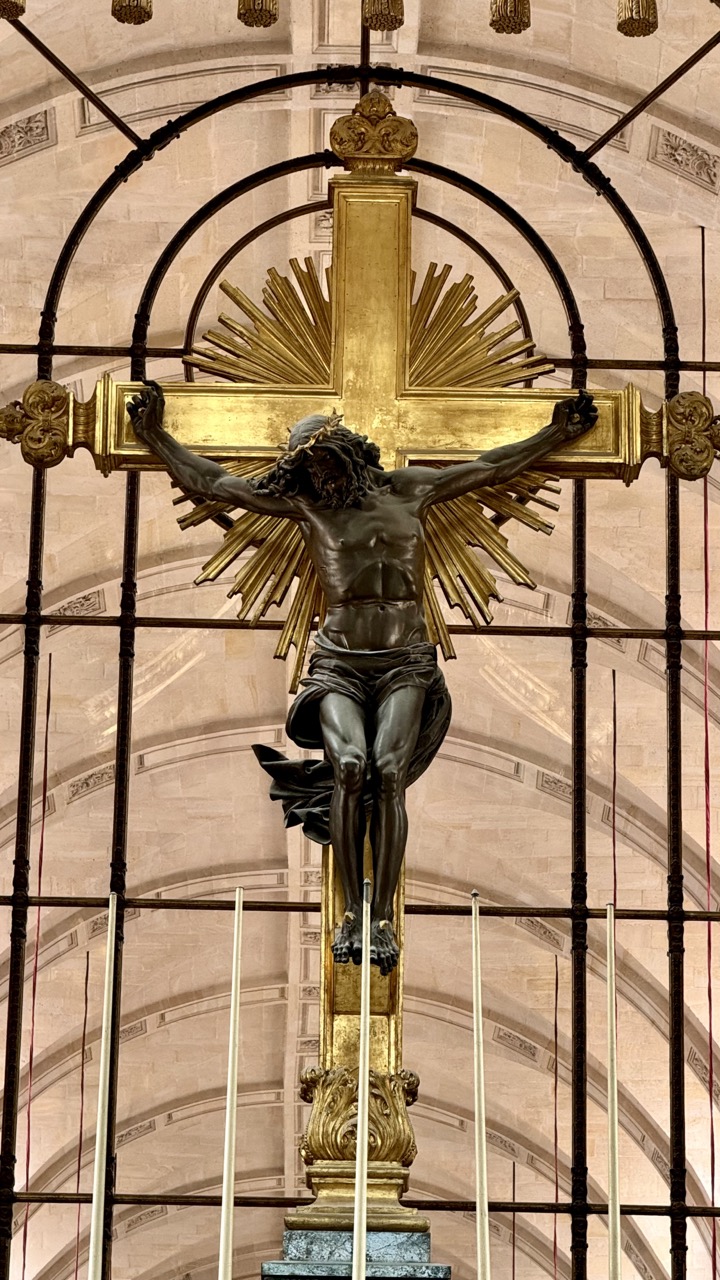

Crucifix Behind Bars
Rating: 9/10
This striking image captures a powerful religious artifact: a large crucifix featuring a dark, bronze-like sculpture of Christ on a brilliant golden cross, complete with a dramatic sunburst emanating from behind the figure. The setting appears to be a grand church or cathedral, with glimpses of vaulted ceilings and intricate stone work visible in the background, suggesting a place of significant scale and history. In the foreground, a metal gate or screen with vertical bars creates a layer between the viewer and the sacred object, adding a sense of distance or perhaps a protective barrier. The mood is undoubtedly solemn and reverent, befitting the subject matter, amplified by the dramatic lighting that highlights the central figure.
From a photographic standpoint, the composition is classically symmetrical, centering the powerful crucifix within the frame. While this is a safe and effective choice for showcasing the subject, the vertical bars in the foreground add an interesting, albeit slightly distracting, element – perhaps they're meant to evoke a sense of viewing through a sacred enclosure, or maybe the photographer just couldn't get closer without buying a VIP ticket. The lighting is key here, expertly using contrast to make the figure of Christ stand out against the glowing gold of the cross and the soft, diffused background. The warm tones of the stone ceiling complement the gold, creating a rich, historical atmosphere. Overall, it's a well-executed shot that captures the grandeur and spiritual weight of the artifact, despite having to shoot through what looks like a particularly fancy set of church railings.
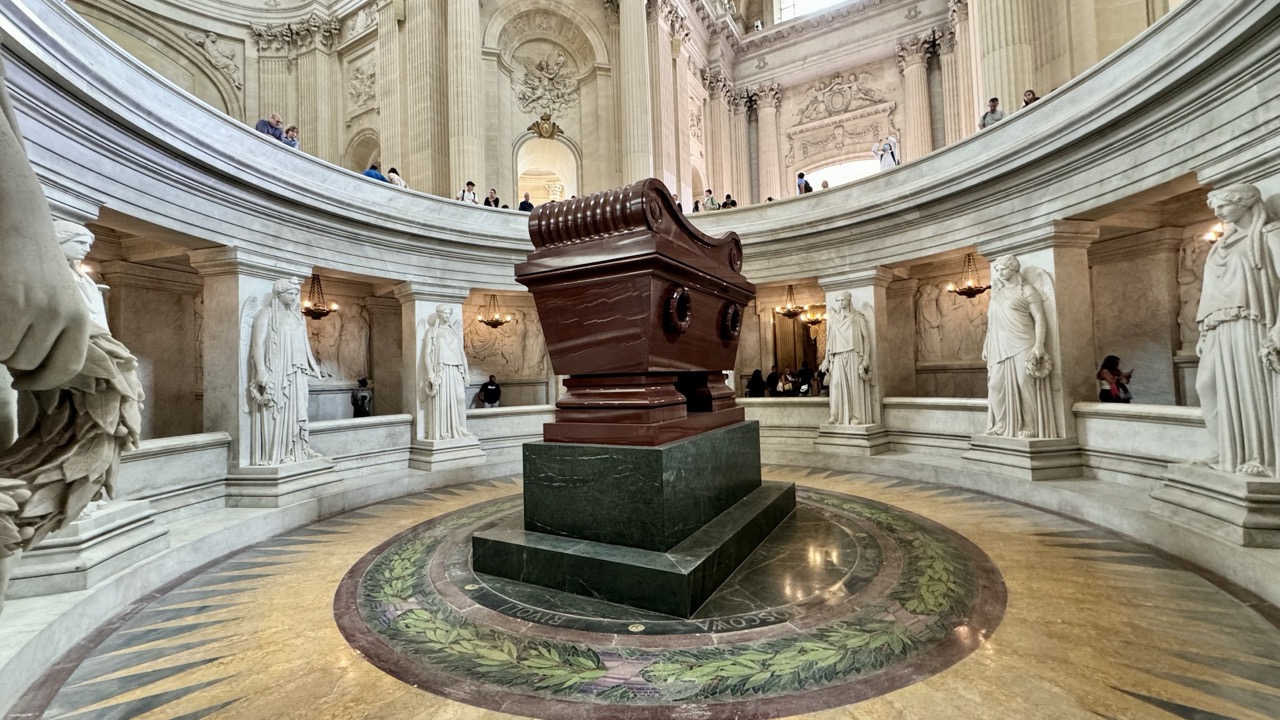

Napoleon's Grand Bedrock
Subject Rating: 9/10
Here lies Napoleon, seemingly buried under more marble and history than anyone else on Earth. The grand sarcophagus, a hefty chunk of reddish-brown porphyry, takes center stage, looking less like a final resting place and more like a very elaborate, and frankly, slightly ostentatious, chest of drawers for history's most famous short guy. Surrounding him are majestic white statues, standing guard like silent sentinels, while onlookers peer down from an upper balcony, perhaps contemplating the sheer weight of history (or just trying to get a decent photo angle without someone's head in the way). The circular room at Les Invalides provides a suitably awe-inspiring backdrop, complete with ornate details and the names of battles etched into the floor, just in case you forgot who this whole enormous display was for. The mood is undeniably solemn and grand, mixed with the usual tourist hustle – a fascinating juxtaposition of historical reverence and modern-day snapshotting.
From a photographic standpoint, this shot nails the architectural symmetry, placing the tomb firmly at the heart of the composition, just as it is in reality and history. The circular layout is captured effectively, drawing the eye around the space and emphasizing the scale. Lighting is even, ambient, and perhaps a touch flat, but it prevents harsh shadows and allows the details of the marble work and the tomb itself to be seen clearly. The color palette is rich but subdued – the deep red of the sarcophagus pops against the cool white and grey marble, punctuated by the green base and floor inlay. It's a challenging subject given the scale and the inevitable crowds, but the photographer has managed to convey the grandeur and historical significance of the space, even if getting a perfectly empty shot felt about as likely as Napoleon winning at Waterloo this time around.


Grand Hall of Giants
Rating: 9/10
Stepping into this colossal space feels like entering a dream built by giants who had a penchant for extremely fancy marble. The foreground is dominated by a breathtaking grand staircase made of deep green marble, its ornate balustrade flowing elegantly. Beside it stands a truly unique column, a black and white twisted marble wonder topped with shimmering gold, looking like a luxurious barber's pole on steroids. The sheer scale of the architecture is overwhelming, with towering cream-colored columns supporting soaring arches and vaulted ceilings adorned with intricate patterns and carvings. High above, glimpses of painted frescos and a central dome add splashes of color and grandeur. A few human figures wander through the vast hall, appearing remarkably small against the monumental backdrop, offering a sense of perspective to the historical scale of the place. The overall mood is one of awe and wonder, a testament to incredible craftsmanship and wealth.
From a photographer's perspective, this shot bravely embraces the challenge of capturing a space bursting with detail. The low angle effectively emphasizes the immense height and volume of the hall, making the viewer crane their neck just looking at the image. The composition uses the staircase and the dramatic spiral column as strong foreground anchors, leading the eye upwards and into the depth of the scene. The contrast between the richly colored marble in the foreground and the lighter stone and painted ceilings in the background is well-managed. The natural lighting filtering in from above highlights the textures and architectural elements, though the dynamic range of the scene (bright windows vs. shadowed corners) is tricky. It's a visually busy image, reflecting the ornate nature of the subject, and successfully conveys the feeling of being immersed in this incredibly grand environment, making you almost hear the echoes.
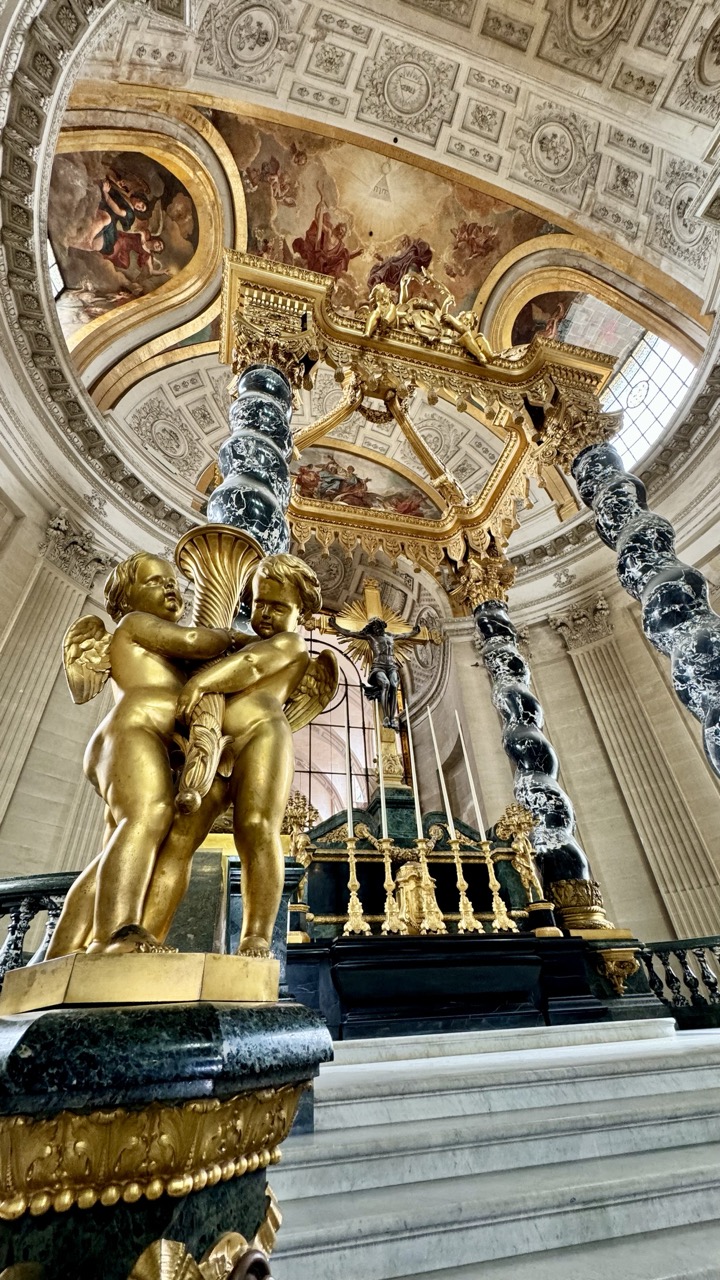

Golden Guardians and Heavenly Drama
Rating: 8/10
Step right up to the visual feast of a place where gold is apparently a structural material and cherubs have important tasks involving shiny objects. This shot plunges us into the opulent heart of a grand interior, likely a cathedral or royal chapel, dominated by towering, twisted black columns and a breathtaking gilded canopy that probably cost more than a small country. The mood is overwhelmingly majestic, perhaps a touch overwhelming, with so much dazzling detail vying for attention. Front and center, two robust golden cherubs seem locked in an eternal embrace with a large, finned... thing? Is it a fish? A cornucopia? Whatever it is, they're holding it with the kind of intensity usually reserved for guarding the crown jewels. Behind them, a solemn crucifix stands atop a dark, marble-like altar, flanked by golden candlesticks, while the gilded baldachin reaches towards a beautifully painted ceiling portraying scenes that look dramatically important, though perhaps a tad faded with time.
Photographically speaking, this is the classic "look up and get amazed (and maybe a stiff neck)" shot. The low-angle composition effectively emphasizes the scale and height, though it introduces a bit of the characteristic wide-angle lean you often get trying to fit everything in with a smartphone. The lighting is generous, making the gold elements truly pop and gleam, creating a high-contrast scene against the darker columns and altar base. The color palette screams 'lavish', with the warm golds and earthy tones of the ceiling contrasting with the stark black and white marble patterns. It’s a brave attempt to capture the sheer density of detail in such a rich environment, navigating tricky perspectives and varied lighting. Despite the slight tilt, the image successfully conveys the breathtaking, almost excessive, grandeur of the space, leaving you to ponder what exactly those cherubs are doing and if they ever get tired of holding that... fish.
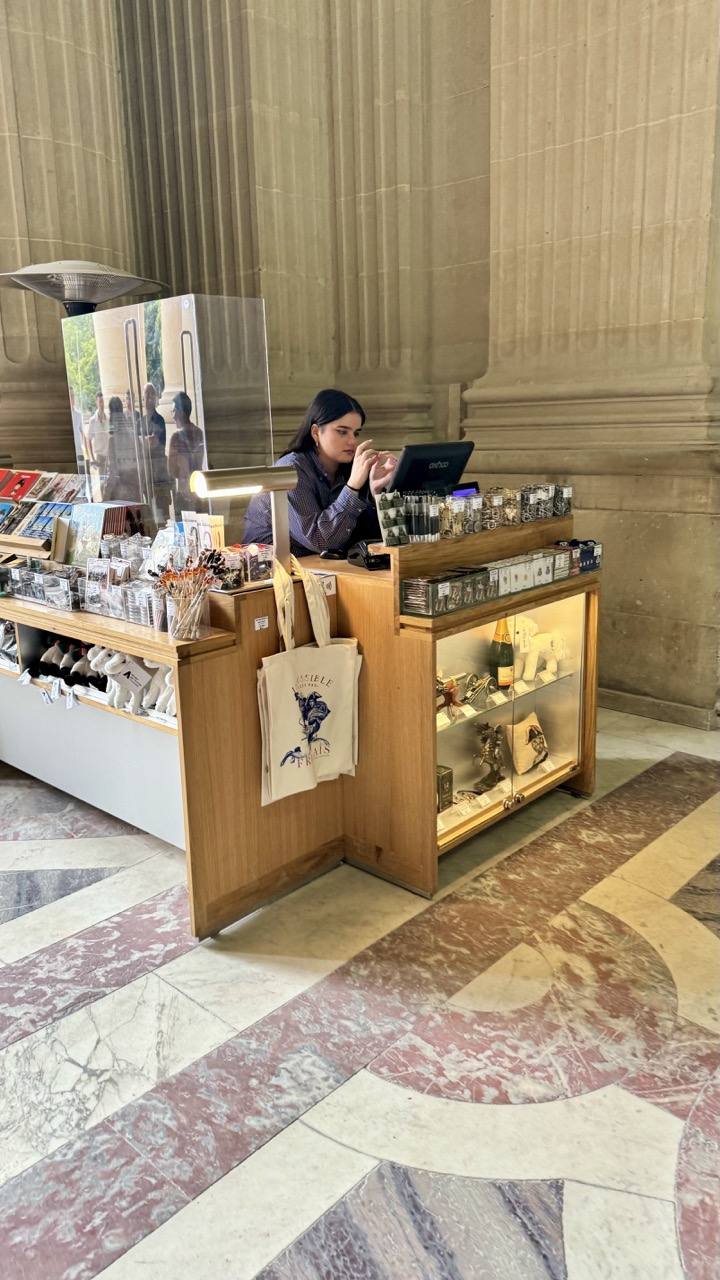

The Daily Grind in the Grand Hall
Rating: 6.5/10
This image captures a candid moment of modern work juxtaposed against a backdrop of classical grandeur. Our primary subject, a young woman, is intently focused on her laptop behind a wooden shop counter laden with touristy bits and bobs – from books and bottles to what appear to be small sculptures and stuffed animals. Behind her, a large glass panel reflects the scene outside or across the room, showing blurred figures walking, adding another layer of visual information and a slight sense of depth, even if it's just a reflection. The counter itself is a cluttered but organized display of commerce, featuring everything from postcards to champagne bottles, suggesting this is likely a gift shop or information point within a museum or grand public building. The composition places the counter centrally, anchoring the scene, while the woman's focused posture directs the viewer's eye.
The setting is undoubtedly the star, even if the human element is the focal point. Towering fluted columns, rendered in warm, muted stone, rise behind the counter, hinting at the immense scale of the space. The lighting is a mix; a bright lamp illuminates the top of the counter, casting a warm glow on the merchandise and the woman's hands, while the rest of the scene relies on more diffuse ambient light from unseen sources, leaving the upper reaches of the columns in shadow. The most striking visual element is the floor, a stunning mosaic of polished marble in varying shades of purple, red, and white, laid out in an intricate geometric pattern. This floor provides a rich, textured foreground that contrasts beautifully with the smooth stone and wood above, adding a touch of opulent detail that elevates the everyday scene occurring upon it. It's a shot that highlights the contrast between the mundane tasks of the present and the timeless architecture of the past.


The Great Cone-spiracy
Rating: 7/10
Ah, the majestic cone-shaped arboreal sentinels standing guard over this impeccably manicured urban oasis! The subject, a formal garden complete with intensely geometric topiaries and neatly trimmed boxwood hedges, scores a respectable 7/10 – points for dedication to shape, but a slight deduction for making me crave ice cream. The scene unfolds on a rather moody, overcast day, lending a quiet, slightly formal tone to the proceedings. You can almost hear the distant hum of city life muted by the disciplined greenery. Besides the star-studded cone cast and their boxy costars, we see winding gravel paths inviting a contemplative stroll, or perhaps a spirited game of hide-and-seek among the bushes.
From a photographic standpoint, the composition features a rather assertive, blurry foreground of leaves, which either adds intriguing depth or is a result of the photographer deciding "soft focus is the new sharp." The midground showcases the main event with its green geometric marvels and structured hedges, leading the eye back to the lush line of trees and the classic, slightly weathered buildings in the background, topped with charming chimneys and dormer windows. The lighting is that classic overcast diffuseness, perfect for soft greens but perhaps lacking a bit of pop. The overall color palette is subdued, dominated by greens, browns, and the muted grey of the sky. It's a classic garden landscape style, attempting to capture the structured beauty against the urban backdrop, perhaps a bit understated by the flat lighting but undeniably highlighting the sheer commitment to horticultural architecture. One must appreciate the effort, even if the cones look like they're about to launch.